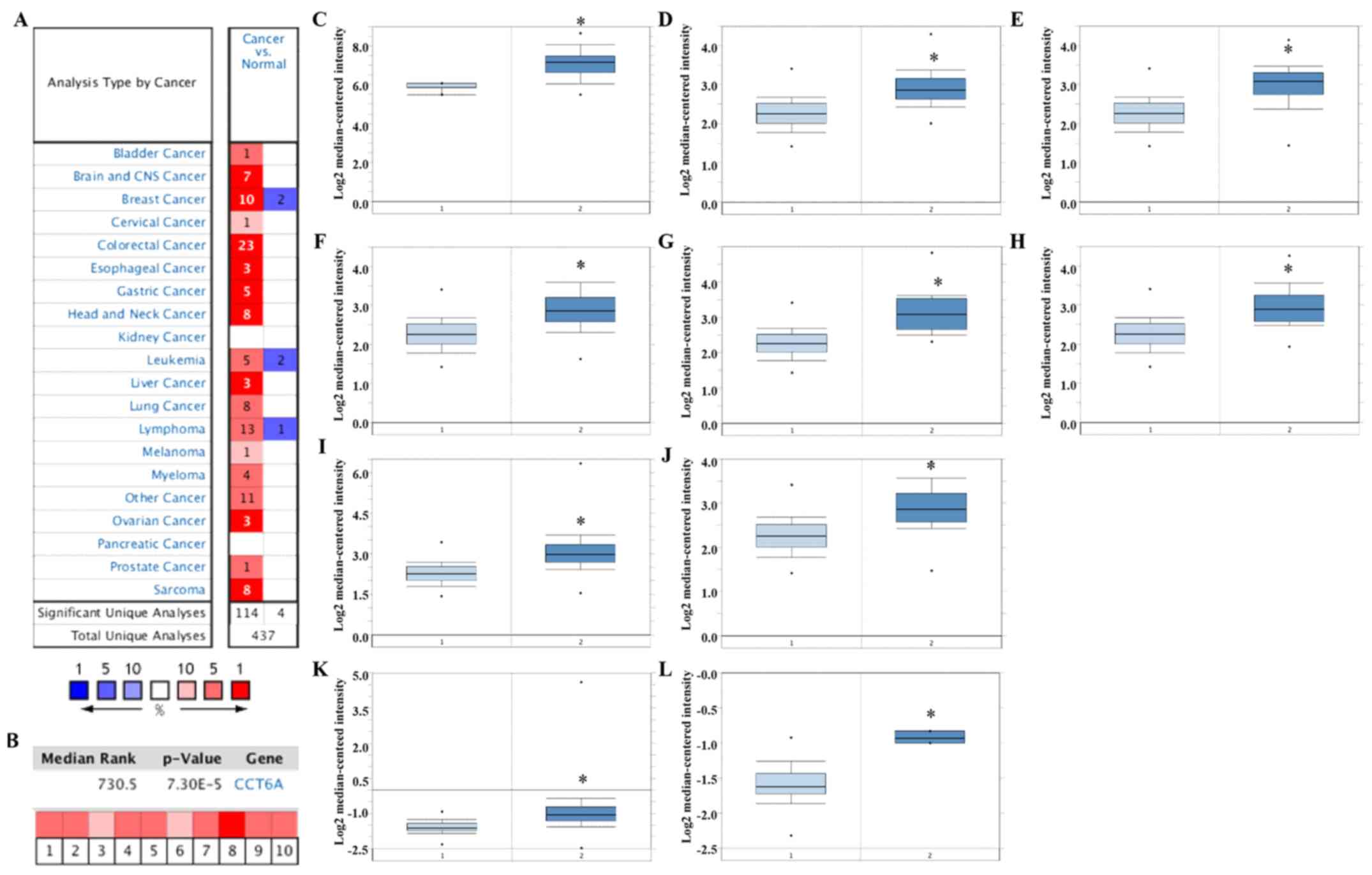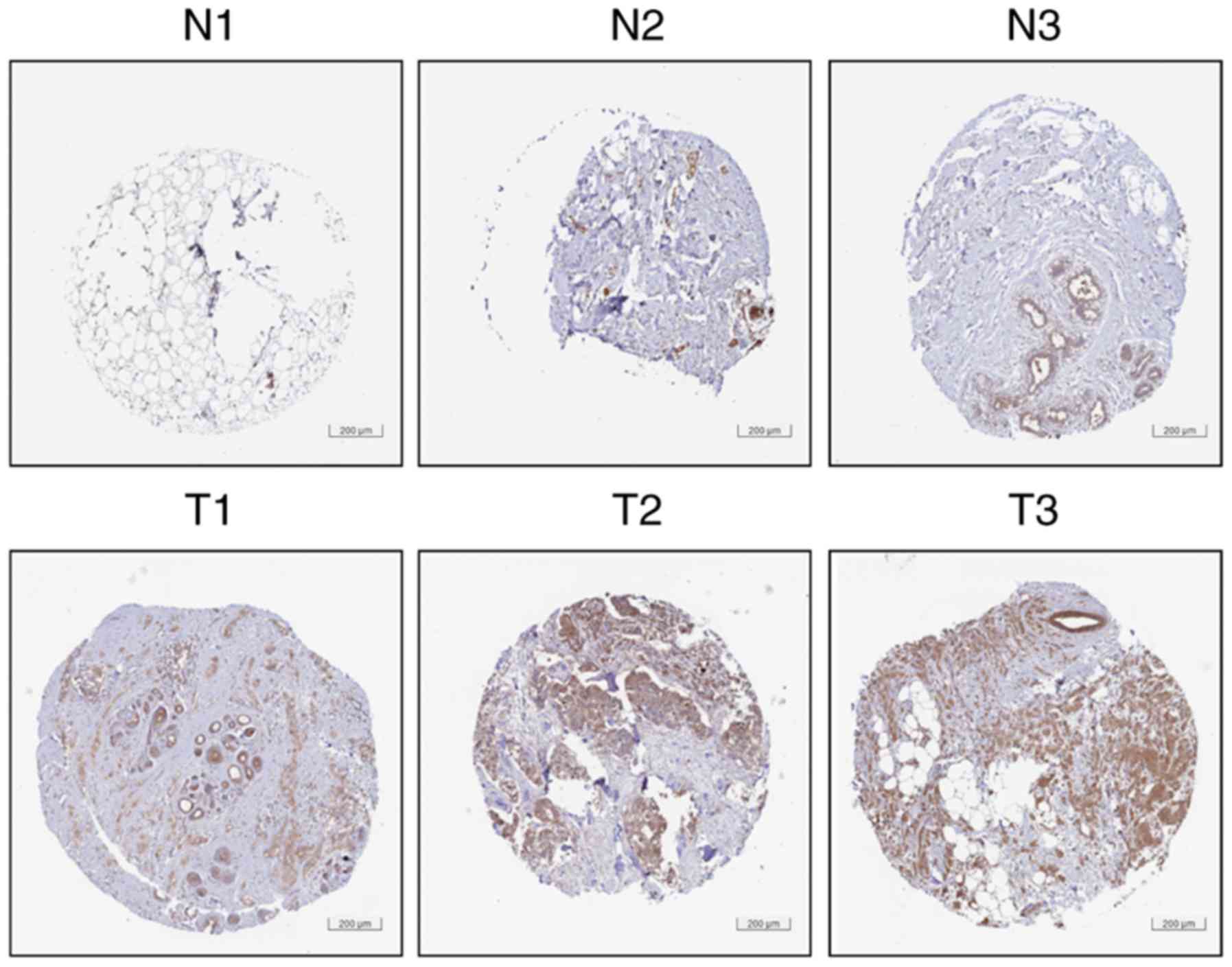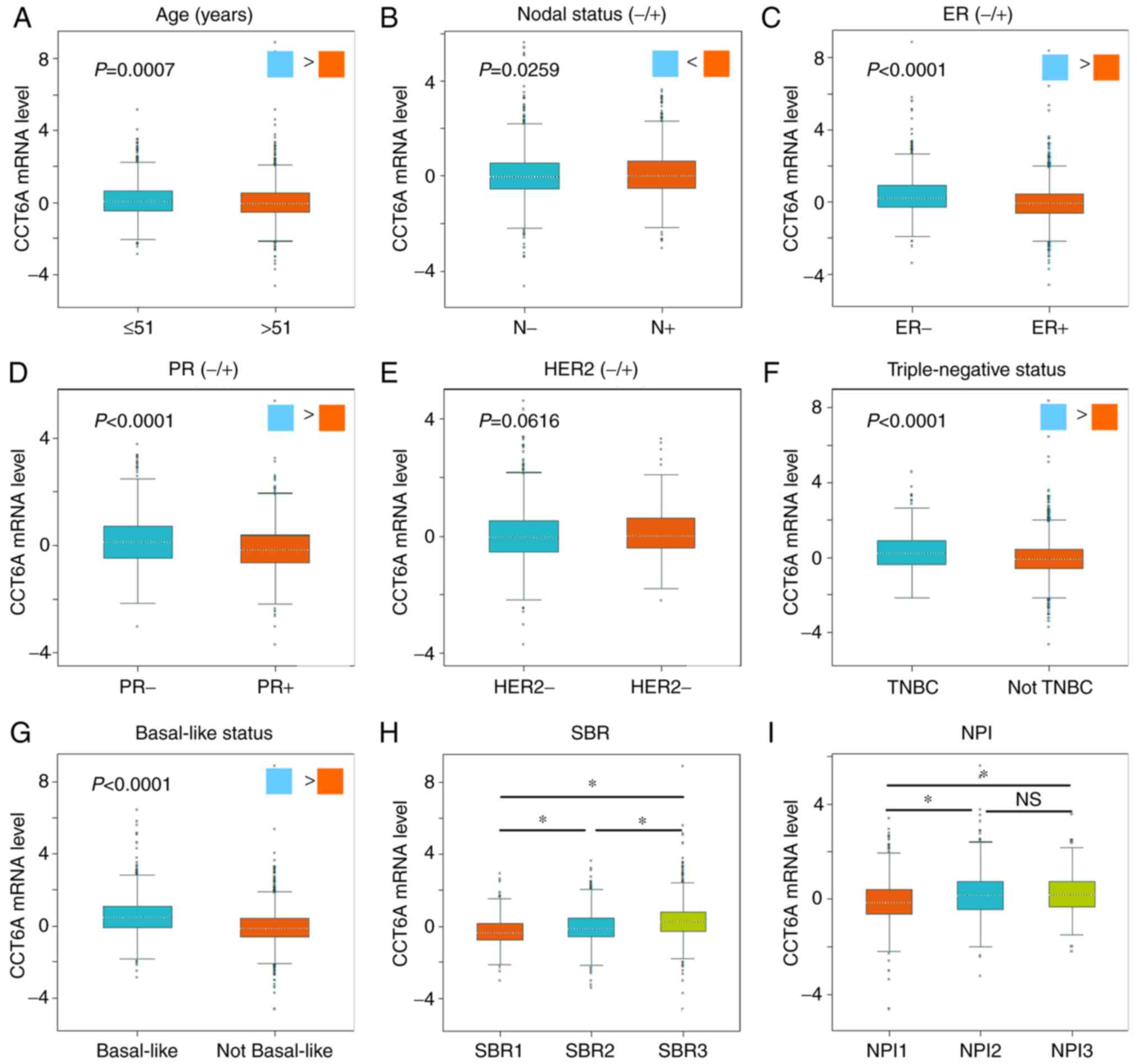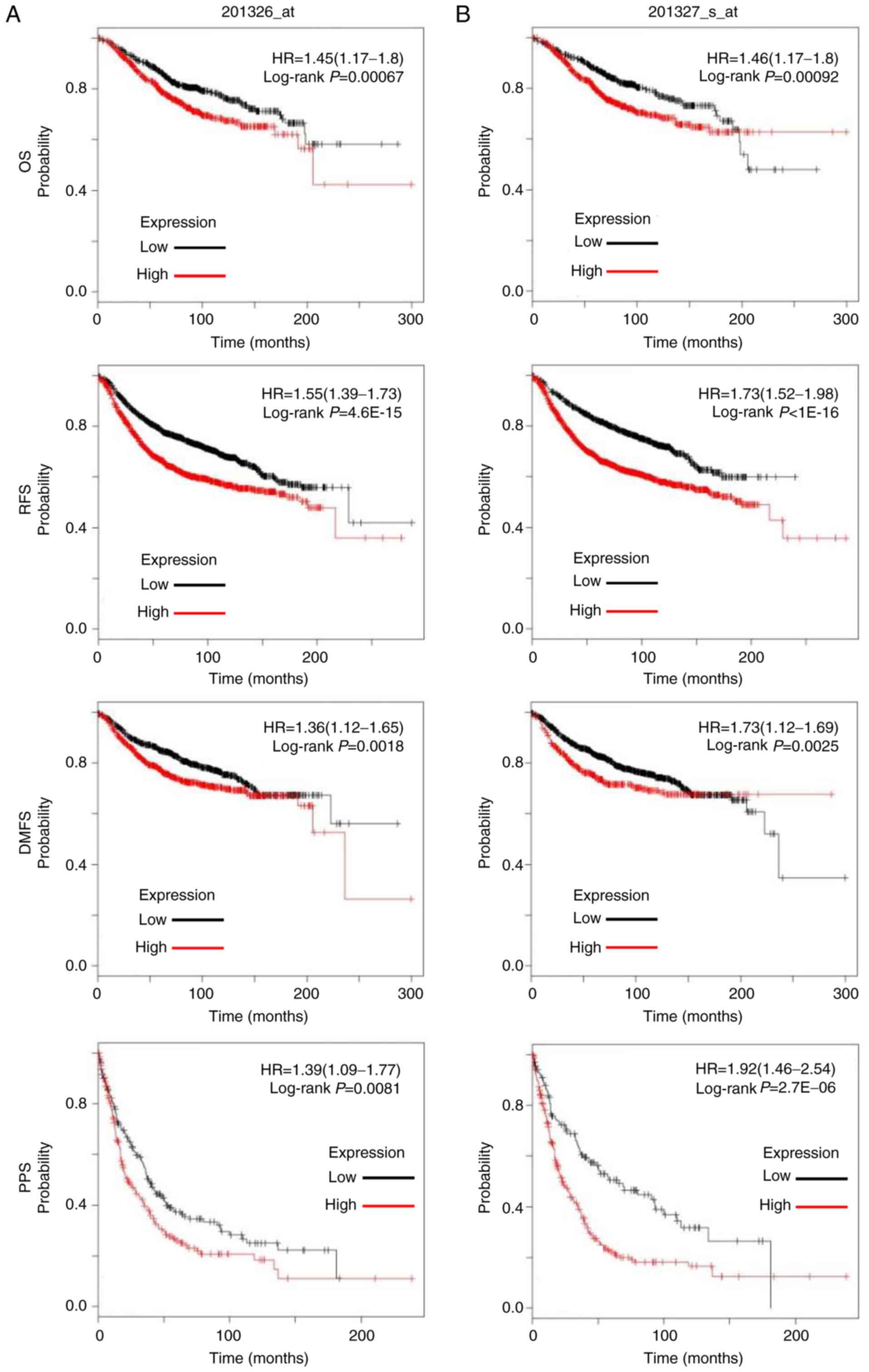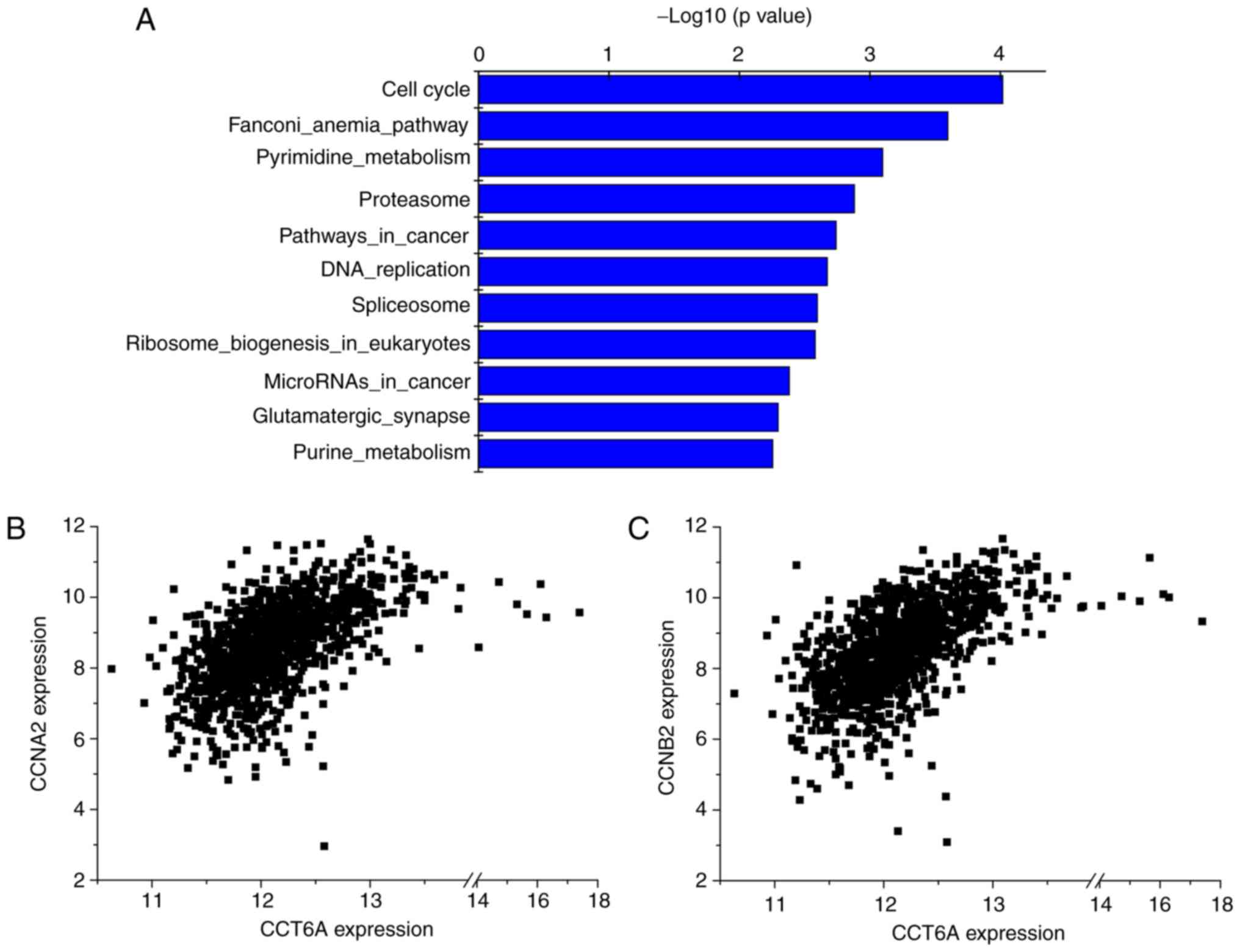Bioinformatics analysis of the prognostic value of CCT6A and associated signalling pathways in breast cancer
- Authors:
- Published online on: March 28, 2019 https://doi.org/10.3892/mmr.2019.10100
- Pages: 4344-4352
-
Copyright: © Huang et al. This is an open access article distributed under the terms of Creative Commons Attribution License.
Abstract
Introduction
Breast cancer (BC) is the most frequently diagnosed type of cancer and the leading cause of cancer-associated mortality among women worldwide; ~1.7 million new diagnoses and 521,900 cases of mortality are attributed to BC annually (1). However, despite extensive studies focussing on BC, and the development of novel and less toxic treatment regimens, the survival rates for patients with BC remain low (2). Therefore, the identification of more valuable and convenient biomarkers for early diagnosis and survival prediction, as well as novel therapeutic target genes for effective treatment, is urgently required.
Chaperonin-containing TCP1 subunit 6A (CCT6A) is the ζ subunit of the chaperonin-containing TCP1 complex (CCT), which comprises two identical rings stacked back to back, each containing eight different homologous proteins (1–8 or α-θ); the protein encoded by CCT6A functions as a molecular chaperone (3–5). Previous studies have indicated that 5–10% of all newly synthesised cytoplasmic proteins appear to pass this chaperone, suggesting it has an essential role in cytoskeletal organisation and in the cell cycle (6,7). As a subunit of the CCT family, CCT6A is essential for the correct folding and oligomerisation/polymerisation of native proteins, with actin and tubulin being the major substrates (8). Furthermore, CCT6A has been identified as a specific component of endogenous extracellular signal-regulated kinase (ERK)1/2 signalling complexes (9) that possesses phosphorylation sites for mitogen-activated protein kinase (MAPK)/ERK (10,11). In addition, CCT6A and the MAPK signalling pathway serve a critical role in matrix metalloproteinase-3-dependent regulation of neurite outgrowth and neuronal migration in the developing brain (7).
Previous studies have revealed that CCT6A expression is significantly increased in 10 human tumour cell lines and drug-resistant human melanoma cell lines, suggesting that CCT6A may have a critical role in tumorigenesis and drug resistance (12,13). In addition, a recent experimental study on lung cancer indicated that CCT6A overexpression significantly increases colony and tumour sphere formation, as well as side population, and reduces sensitivity to anoikis in A549 cells following transforming growth factor (TGF)-β stimulation (14). However, the functional significance of CCT6A in other types of cancer, including BC, has yet to be investigated.
To determine the significance of CCT6A in BC, the present study evaluated CCT6A expression in various tumours, including BC, and analysed its association with survival, clinicopathological parameters and related signalling pathways using online datasets. The results revealed that various cancer tissues exhibited significantly higher CCT6A expression compared within noncancerous tissues, and increased CCT6A expression in BC tissues was significantly associated with poor patient prognosis. Furthermore, pathways based on associated genes indicated that CCT6A was significantly associated with the cell cycle, and its expression was significantly positively correlated with cyclin (CCN)B2 and CCNA2 expression. Collectively, these findings suggested that CCT6A may have an important role in BC progression.
Materials and methods
Oncomine analysis
Gene expression array datasets from the online cancer microarray database Oncomine (www.oncomine.org) (15) were used to evaluate CCT6A mRNA expression in various tumour samples. CCT6A mRNA expression in BC tissues was compared with that in normal control tissues using 10 datasets from 3 cohorts (16,17). The fold change in CCT6A expression from different datasets was presented using scatter plots. The datasets used in this study are listed in Table I. Details regarding standardised normalisation techniques and statistical calculations are provided on the Oncomine website (18). The search parameters and filters used to find the datasets were set as follows: P-value, 0.05; fold change, 1.5; gene rank, 10%; analysis type, cancer vs. normal analysis; data type, mRNA.
Human Protein Atlas (HPA)
CCT6A expression was further evaluated using the publicly available HPA (www.proteinatlas.org; version 18). The HPA is a database containing images of tissue microarrays labelled with antibodies against 11,250 human proteins (19). These tissue microarrays comprise sections from 46 normal human tissues and 20 types of human cancer. Analyses were performed using HPA images of breast sections labelled with CCT6A antibody (cat. no. HPA042996; Sigma-Aldrich; Merck KGaA, Darmstadt, Germany).
Kaplan-Meier plotter
The Kaplan-Meier plotter (www.kmplot.com) is an online database containing gene expression data and survival information from 4,142 clinical patients with BC (20,21). To further investigate the prognostic value of CCT6A mRNA expression in BC, this study analysed the association between CCT6A mRNA expression and survival, including overall survival (OS), relapse-free survival (RFS), distant metastasis-free survival (DMFS) and post progression survival (PPS), in patients with BC. Samples from patients with BC were divided into two groups according to median CCT6A expression (high vs. low expression), after which the association between CCT6A mRNA expression and survival was analysed using a Kaplan-Meier survival plot together with hazard ratio, 95% confidence interval and log-rank P-value.
Breast Cancer Gene-Expression Miner v4.0 (bc-GenExMiner v4.0)
The bc-GenExMiner v4.0 (http://bcgenex.centregauducheau.fr/BC-GEM/GEM-Accueil.php?js=1) contains 36 annotated genomic datasets and three statistical mining functions (22,23). The bc-GenExMiner v4.0 was used to compare target gene expression according to clinical criteria. The present study analysed the association between CCT6A expression and hormonal receptors, nodal status and other factors, in order to assess the prognostic impact of this candidate gene in human BC and to provide potential prognostic markers for BC.
R2 application
R2: Genomics Analysis and Visualisation Platform (http://r2.amc.nl) (24) is a web-based genomics analysis and visualisation application, which was used to investigate CCT6A-related signalling pathways and genes. Pathway enrichment analysis based on CCT6A-associated genes was performed using the R2 Kyoto Encyclopedia of Genes and Genomes (KEGG) Pathway Finder and the standard setting in The Cancer Genome Atlas (TCGA) collection (BRCA was the TCGA ID and the search term in R2) (15). Furthermore, the correlation between CCT6A expression and related gene expression was calculated using the Pearson test based on the expression in BC cancer tissues and noncancerous normal tissues. The related genes were identified through the R2 Platform by searching ‘Find Correlated genes with a single gene’ or ‘Correlate two genes’. The r-value, P-value and T-value were calculated and provided by R2.
Statistical analysis
The expression of CCT6A in BC tissues and noncancerous breast tissues was presented as the means ± 10% of percentile of the median intensity. Comparison of CCT6A expression between BC tissues and noncancerous breast tissues using the Oncomine data was performed using Student's t-test. The association between CCT6A mRNA expression and survival was analysed using Kaplan-Meier survival plots, which were statistically compared using the log-rank test on the Kaplan-Meier plotter website. Using the R2 website, the correlation between CCT6A expression and the expression of related genes was analysed using the Pearson test in BC samples, and the r-, P- and T-values were calculated and presented. The association between CCT6A and age, nodal status (+/-), receptor statuses [estrogen receptor (ER)+ vs. ER−, progesterone receptor (PR)+ vs. PR−, human epidermal growth factor receptor 2 (HER2)+ vs. HER2−] and triple-negative status was performed using a Welch's analysis of variance (ANOVA); if global significant differences were found (for correlation analysis of CCT6A with SBR and NPI grades), Dunnett-Tukey-Kramer's post-hoc test was performed to compare the differences among groups. P<0.05 was considered to indicate a statistically significant difference.
Results
CCT6A upregulation in BC tissues
Analyses of mRNA expression in various tumour samples from the Oncomine platform indicated that CCT6A expression was significantly higher in tumour tissues compared with matched normal tissues (Fig. 1A). In particular, CCT6A was significantly upregulated in BC tissues compared with in noncancerous breast tissues (Fig. 1B-L; P<0.05). Details of CCT6A expression in these datasets are listed in Table I. Accordingly, as presented in Fig. 2, HPA (version 18) data analyses confirmed that BC tissues (images of T1-T3 available from https://www.proteinatlas.org/ENSG00000146731-CCT6A/pathology/tissue/breast+cancer#img) exhibited higher protein expression levels of CCT6A compared with normal breast tissues (images of N1-N3 available from http://www.proteinatlas.org/ENSG00000146731-CCT6A/tissue/breast#img).
Collectively, the aforementioned analyses demonstrated that the mRNA and protein expression levels of CCT6A were higher in BC tissues than in normal breast tissues, thus suggesting that CCT6A may act as an oncogene that promotes BC.
Association between CCT6A mRNA expression and clinicopathological parameters in patients with BC
Using Welch's ANOVA, CCT6A mRNA expression was compared among groups of patients with various clinicopathological parameters using bc-GenExMiner (Fig. 3 and Table II). In terms of age, CCT6A mRNA expression was lower in the older group (>51 years; Fig. 3A; P=0.0007). Furthermore, among patients with BC, those with positive nodal status exhibited higher CCT6A mRNA expression than those with negative nodal status (Fig. 3B; P=0.0259). The ER and PR status of patients with BC was also negatively associated with CCT6A mRNA expression (Fig. 3C and D; P<0.0001). However, there was no difference in CCT6A expression between patients with HER2− and HER2+ BC (Fig. 3E; P=0.0616). Triple-negative BC (TNBC) is a type of BC characterised by ER−, PR− and HER2−. CCT6A mRNA expression was significantly upregulated in patients with TNBC (Fig. 3F; P<0.0001). The results also indicated that patients with basal-like BC exhibited higher CCT6A mRNA expression than those without basal-like BC (Fig. 3G; P<0.0001). With regards to Scarff-Bloom-Richardson (SBR) grading (25), a more advanced SBR grade was significantly associated with higher CCT6A mRNA expression (Fig. 3H; P<0.0001) compared with other SBR grades. Furthermore, a more advanced Nottingham prognostic index (NPI) grade (26) was associated with higher CCT6A mRNA expression (Fig. 3I; P<0.0001) compared with other NPI grades.
Table II.Association between mRNA expression of chaperonin-containing TCP1 subunit 6Aand clinicopathological parameters of breast cancer. |
Higher CCT6A expression is associated with poor survival in patients with BC
Using the Kaplan-Meier plotter, the association between CCT6A expression and survival in patients with BC was evaluated. Kaplan-Meier analysis revealed that high CCT6A expression (Affymetrix microarrays, 201326-at and 201327_s_at; Fig. 4A and B) in BC tissues was significantly associated with shorter OS (P<0.05), RFS (P<0.05), DMFS (P<0.05) and PPS (P<0.05) in patients with BC, thus suggesting that high CCT6A expression may be predictive of poor prognosis.
Possible involvement of CCT6A in the cell cycle and its positive correlation with CCNB2 and CCNA2
To further investigate the signalling pathways in which CCT6A might be involved, pathway enrichment analysis was performed using the R2 KEGG Pathway Finder based on CCT6A-associated genes in BC tissues from TCGA dataset (ID: BRCA). Accordingly, the top 10 signalling pathways associated with CCT6A, including the ‘cell cycle’, are presented in Fig. 5 and Table III. Among these correlated genes involved in the cell cycle, CCT6A expression was significantly positively correlated with CCNB2 (r-value=0.560; P=1.0×10−91; T-value=22.389) and CCNA2 (r-value=0.532; P=2.7×10−81; T-value=20.807) expression. These results indicated that CCT6A may be involved in the cell cycle signalling pathway.
Table III.Pathway enrichment analysis of chaperonin-containing TCP1 subunit 6A-associated genes in TCGA. |
Discussion
BC is the most common malignant tumour among women worldwide (1), and has been reported to be associated with the overexpression of oncogenes (27–29). Despite significant improvements in the diagnosis, treatment and survival prediction of BC, the identification of novel biomarkers for prognosis is urgently required. Studies have revealed that CCT6A expression is increased in 10 human tumour cell lines and drug-resistant human melanoma cell lines (12,13). However, to the best of our knowledge, its expression in clinical tumour samples has not been evaluated previously. Using the online Oncomine dataset, the present study demonstrated that the majority of tumour tissues, including breast, lung, liver and colorectal cancer tissues, exhibited significantly higher CCT6A expression compared within adjacent noncancerous tissues. In the majority of the BC datasets (10/12), BC tissues exhibited significantly higher CCT6A mRNA expression compared with in noncancerous breast tissues; the same observation was confirmed at the protein level by immunohistochemistry (IHC) through HPA. These results indicated that CCT6A may be among the overexpressed genes in tumour tissues and may serve a critical role in tumorigenesis. However, the protein expression levels of CCT6A in BC samples should be further validated via western blot analysis and immunohistochemistry.
It has previously been reported that increased CCT6A expression is significantly associated with poor survival in patients who have high TGF-β levels in lung cancer tissues, but not in those with low TGF-β levels, suggesting that CCT6A serves as a valuable biomarker for lung cancer (14). Using the Kaplan-Meier plotter, it was demonstrated that high CCT6A expression was significantly associated with unfavourable OS, RFS, DMFS and PPS in all patients with BC, indicating that CCT6A mRNA expression may serve as a prognostic indicator in patients with BC. In addition, CCT6A overexpression in cancer cells significantly shortens the survival time in tumour-bearing mice, whereas CCT6A knockdown significantly prolongs survival (14). Taken together, these observations further support the role of CCT6A as an essential biomarker for survival prediction in patients with cancer, including BC.
BC is classified into distinct histological and biological subtypes with different pathological, molecular and clinical features (30). Therefore, this study further investigated the association between CCT6A expression, at both the mRNA and protein levels, and clinicopathological parameters in patients with BC. The findings indicated that high CCT6A expression was negatively associated with ER and PR status, and positively associated with nodal, basal-like and TNBC status. Furthermore, higher SBR and NPI grades were significantly associated with higher CCT6A expression. HER2 is a member of the epidermal growth factor receptor family (31), and is associated with poor outcome in patients with BC. However, this study found no association between CCT6A expression and HER2 status. Taken together, these findings demonstrated that increased CCT6A expression may be significantly associated with poor outcomes in patients with BC, while possibly serving as a novel biomarker for the prognosis of BC.
The evaluation of biological functions has revealed that CCT6A overexpression significantly increases colony and tumour sphere formation, increases side population and reduces sensitivity to anoikis in A549 cells following TGF-β stimulation (14). However, to the best of our knowledge, the biological functions and underlying mechanism of CCT6A in BC remain to be evaluated. Accordingly, following the analyses of signalling pathways associated with CCT6A based on correlated genes, it was demonstrated that ‘cell cycle’ was among the most enriched KEGG signalling pathways. In addition, CCT6A expression was positively correlated with the expression of CCNB2 and CCNA2, two important cell cycle regulators, thus suggesting that CCT6A may be involved in tumour growth mediated by the cell cycle. However, further investigations on the biological function and underlying mechanism of action of CCT6A in BC are required. Future studies should aim to assess the role of CCT6A in growth, metastasis and chemotherapeutic resistance in cancer, including BC, which may improve understanding of the role of CCT6A in the progression of cancer.
In conclusion, the present study revealed that BC tissues exhibited significantly higher CCT6A expression compared with in noncancerous breast tissues at the mRNA and protein levels. In addition, increased CCT6A expression was significantly associated with unfavourable survival in patients with BC. Furthermore, CCT6A expression was negatively associated with ER and PR status, positively correlated with nodal, basal-like and TNBC status, and was increased in patients with advanced SBR and NPI grades. CCT6A was also revealed to be involved in the cell cycle, and its expression was positively correlated with CCNB2 and CCNA2 expression. Collectively, CCT6A may be a potential target in BC.
Acknowledgements
Not applicable.
Funding
No funding was received.
Availability of data and materials
The datasets used and/or analysed during the current study are available from the corresponding author on reasonable request. The images presented in Fig. 2 were provided by the Human Protein Atlas: BC tissues (https://www.proteinatlas.org/ENSG00000146731-CCT6A/pathology/tissue/breast+cancer#img); normal breast tissues (https://www.proteinatlas.org/ENSG00000146731-CCT6A/tissue/breast#img).
Authors' contributions
KH and YW conceived and designed the experiments. KH and YZ performed the Oncomine analysis. YX and LH conducted the HPA analysis. YZ and YX conducted the Breast Cancer Gene-Expression Miner analysis. LH and YX conducted the survival analysis. YW conducted the R2 KEGG Pathway Finder analysis. KH and YW wrote the manuscript. All authors read and approved the final manuscript.
Ethics approval and consent to participate
Not applicable.
Patient consent for publication
Not applicable.
Competing interests
The authors declare that they have no competing interests.
References
|
Siegel RL, Miller KD and Jemal A: Cancer statistics, 2017. CA Cancer J Clin. 67:7–30. 2017. View Article : Google Scholar : PubMed/NCBI | |
|
Yu Y, Walia V and Elble RC: Loss of CLCA4 promotes epithelial-to-mesenchymal transition in breast cancer cells. PLoS One. 8:e839432013. View Article : Google Scholar : PubMed/NCBI | |
|
Hynes G, Kubota H and Willison KR: Antibody characterisation of two distinct conformations of the chaperonin-containing TCP-1 from mouse testis. FEBS Lett. 358:129–132. 1995. View Article : Google Scholar : PubMed/NCBI | |
|
Kubota H, Hynes G, Carne A, Ashworth A and Willison K: Identification of six Tcp-1-related genes encoding divergent subunits of the TCP-1-containing chaperonin. Curr Biol. 4:89–99. 1994. View Article : Google Scholar : PubMed/NCBI | |
|
Rommelaere H, Van Troys M, Gao Y, Melki R, Cowan NJ, Vandekerckhove J and Ampe C: Eukaryotic cytosolic chaperonin contains t-complex polypeptide 1 and seven related subunits. Proc Natl Acad Sci USA. 90:11975–11979. 1993. View Article : Google Scholar : PubMed/NCBI | |
|
Yam AY, Xia Y, Lin HT, Burlingame A, Gerstein M and Frydman J: Defining the TRiC/CCT interactome links chaperonin function to stabilization of newly made proteins with complex topologies. Nat Struct Mol Biol. 15:1255–1262. 2008. View Article : Google Scholar : PubMed/NCBI | |
|
Van Hove I, Verslegers M, Hu TT, Carden M, Arckens L and Moons L: A proteomic approach to understand MMP-3-driven developmental processes in the postnatal cerebellum: Chaperonin CCT6A and MAP kinase as contributing factors. Dev Neurobiol. 75:1033–1048. 2015. View Article : Google Scholar : PubMed/NCBI | |
|
Brackley KI and Grantham J: Activities of the chaperonin containing TCP-1 (CCT): Implications for cell cycle progression and cytoskeletal organisation. Cell Stress Chaperones. 14:23–31. 2009. View Article : Google Scholar : PubMed/NCBI | |
|
von Kriegsheim A, Baiocchi D, Birtwistle M, Sumpton D, Bienvenut W, Morrice N, Yamada K, Lamond A, Kalna G, Orton R, et al: Cell fate decisions are specified by the dynamic ERK interactome. Nat Cell Biol. 11:1458–1464. 2009. View Article : Google Scholar : PubMed/NCBI | |
|
Xiang B, Chatti K, Qiu H, Lakshmi B, Krasnitz A, Hicks J, Yu M, Miller WT and Muthuswamy SK: Brk is coamplified with ErbB2 to promote proliferation in breast cancer. Proc Natl Acad Sci USA. 105:12463–12468. 2008. View Article : Google Scholar : PubMed/NCBI | |
|
Roskoski R Jr: ERK1/2 MAP kinases: Structure, function, and regulation. Pharmacol Res. 66:105–143. 2012. View Article : Google Scholar : PubMed/NCBI | |
|
Tanic N, Brkic G, Dimitrijevic B, Dedovic-Tanic N, Gefen N, Benharroch D and Gopas J: Identification of differentially expressed mRNA transcripts in drug-resistant versus parental human melanoma cell lines. Anticancer Res. 26:2137–2142. 2006.PubMed/NCBI | |
|
Myung JK, Afjehi-Sadat L, Felizardo-Cabatic M, Slavc I and Lubec G: Expressional patterns of chaperones in ten human tumor cell lines. Proteome Sci. 2:82004. View Article : Google Scholar : PubMed/NCBI | |
|
Ying Z, Tian H, Li Y, Lian R, Li W, Wu S, Zhang HZ, Wu J, Liu L, Song J, et al: CCT6A suppresses SMAD2 and promotes prometastatic TGF-β signaling. J Clin Invest. 127:1725–1740. 2017. View Article : Google Scholar : PubMed/NCBI | |
|
Rhodes DR, Yu J, Shanker K, Deshpande N, Varambally R, Ghosh D, Barrette T, Pandey A and Chinnaiyan AM: ONCOMINE: A cancer microarray database and integrateddata-mining platform. Neoplasia. 6:1–6. 2004. View Article : Google Scholar : PubMed/NCBI | |
|
Richardson AL, Wang ZC, De Nicolo A, Lu X, Brown M, Miron A, Liao X, Iglehart JD, Livingston DM and Ganesan S: X chromosomal abnormalities in basal-like human breast cancer. Cancer Cell. 9:121–132. 2006. View Article : Google Scholar : PubMed/NCBI | |
|
Curtis C, Shah SP, Chin SF, Turashvili G, Rueda OM, Dunning MJ, Speed D, Lynch AG, Samarajiwa S, Yuan Y, et al: The genomic and transcriptomic architecture of 2,000 breast tumours reveals novel subgroups. Nature. 486:346–352. 2012. View Article : Google Scholar : PubMed/NCBI | |
|
Shin S, Kim Y, Chul Oh S, Yu N, Lee ST, Rak Choi J and Lee KA: Validation and optimization of the Ion Torrent S5 XL sequencer and Oncomine workflow for BRCA1 and BRCA2 genetic testing. Oncotarget. 8:34858–34866. 2017. View Article : Google Scholar : PubMed/NCBI | |
|
Uhlen M, Oksvold P, Fagerberg L, Lundberg E, Jonasson K, Forsberg M, Zwahlen M, Kampf C, Wester K, Hober S, et al: Towards a knowledge-based Human Protein Atlas. Nat Biotechnol. 28:1248–1250. 2010. View Article : Google Scholar : PubMed/NCBI | |
|
Győrffy B, Surowiak P, Budczies J and Lánczky A: Online survival analysis software to assess the prognostic value of biomarkers using transcriptomic data in non-small-cell lung cancer. PLoS One. 8:e822412013. View Article : Google Scholar : PubMed/NCBI | |
|
Györffy B, Lanczky A, Eklund AC, Denkert C, Budczies J, Li Q and Szallasi Z: An online survival analysis tool to rapidly assess the effect of 22,277 genes on breast cancer prognosis using microarray data of 1,809 patients. Breast Cancer Res Treat. 123:725–731. 2010. View Article : Google Scholar : PubMed/NCBI | |
|
Jézéquel P, Campone M, Gouraud W, Guérin-Charbonnel C, Leux C, Ricolleau G and Campion L: bc-GenExMiner: An easy-to-use online platform for gene prognostic analyses in breast cancer. Breast Cancer Res Treat. 131:765–775. 2012. View Article : Google Scholar : PubMed/NCBI | |
|
Jézéquel P, Frénel JS, Campion L, Guérin-Charbonnel C, Gouraud W, Ricolleau G and Campone M: bc-GenExMiner 3.0: New mining module computes breast cancer gene expression correlation analyses. Database (Oxford). 2013:bas0602013. View Article : Google Scholar : PubMed/NCBI | |
|
Yu Y, Shang R, Chen Y, Li J, Liang Z, Hu J, Liu K and Chen C: Tumor suppressive ZBTB4 inhibits cell growth by regulating cell cycle progression and apoptosis in Ewing sarcoma. Biomed Pharmacother. 100:108–115. 2018. View Article : Google Scholar : PubMed/NCBI | |
|
Le Doussal V, Tubiana-Hulin M, Friedman S, Hacene K, Spyratos F and Brunet M: Prognostic value of histologic grade nuclear components of Scarff-Bloom-Richardson (SBR). An improved score modification based on a multivariate analysis of 1262 invasive ductal breast carcinomas. Cancer. 64:1914–1921. 1989. View Article : Google Scholar : PubMed/NCBI | |
|
Galea MH, Blamey RW, Elston CW and Ellis IO: The Nottingham prognostic index in primary breast cancer. Breast Cancer Res Treat. 22:207–219. 1992. View Article : Google Scholar : PubMed/NCBI | |
|
Li C, Du L, Ren Y, Liu X, Jiao Q, Cui D, Wen M, Wang C, Wei G, Wang Y, et al: SKP2 promotes breast cancer tumorigenesis and radiation tolerance through PDCD4 ubiquitination. J Exp Clin Cancer Res. 38:762019. View Article : Google Scholar : PubMed/NCBI | |
|
Pucci S, Polidoro C, Greggi C, Amati F, Morini E, Murdocca M, Biancolella M, Orlandi A, Sangiuolo F and Novelli G: Pro-oncogenic action of LOX-1 and its splice variant LOX-1Δ4 in breast cancer phenotypes. Cell Death Dis. 10:532019. View Article : Google Scholar : PubMed/NCBI | |
|
O'Toole SA, Selinger CI, Millar EK, Lum T and Beith JM: Molecular assays in breast cancer pathology. Pathology. 43:116–127. 2011. View Article : Google Scholar : PubMed/NCBI | |
|
Michaut M, Chin SF, Majewski I, Severson TM, Bismeijer T, de Koning L, Peeters JK, Schouten PC, Rueda OM, Bosma AJ, et al: Integration of genomic, transcriptomic and proteomic data identifies two biologically distinctsubtypes of invasive lobular breast cancer. Sci Rep. 6:185172016. View Article : Google Scholar : PubMed/NCBI | |
|
Slamon DJ, Clark GM, Wong SG, Levin WJ, Ullrich A and McGuire WL: Human breast cancer: Correlation of relapse and survival with amplification of the HER-2/neu oncogene. Science. 235:177–182. 1987. View Article : Google Scholar : PubMed/NCBI |



